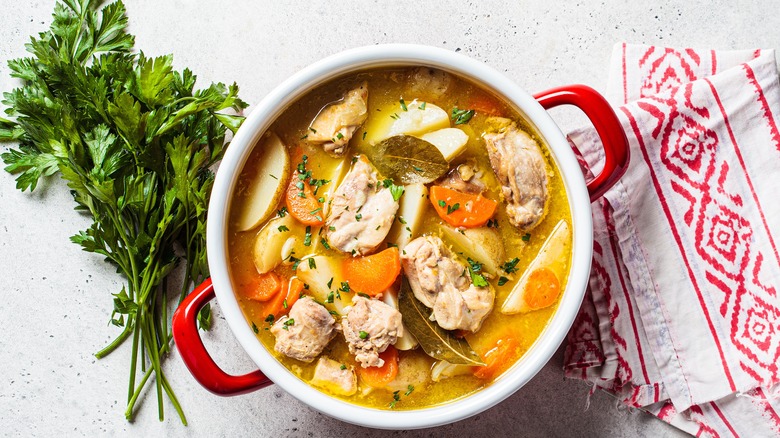The Effortless Shortcut For Flavor-Packed Chicken Soup
When it comes to classic comfort foods, chicken soup stands alone. It's warm, salty, savory, and satisfying, with just the right amount of depth and primal undertones to distinguish it from veggie-based broths. But chicken soup comes in many tastes, textures, and colors — you can find the striking, neon-yellow variety simmering away in those massive kettles at your local or deli or the viscous, almost gloopy stuff that's ready to go right out of the can. However, if you've ever had homemade chicken soup, you know that there's nothing quite like making it yourself.
Chicken soup isn't particularly complicated, but there are a vast number of ways to go about making it. You can use the neck, back, feet, and bones to slowly build a flavorful stock from whole raw chicken, or you can opt for a recipe that uses chicken bouillon or boxed broth/stock as the base of your soup. Both options can be delicious, but if you want to split the difference and make something that has homemade flare without all the hassle of skimming and dish-washing that comes with raw chicken, then you may want to use a bit of a shortcut: rotisserie chicken. Not only does rotisserie chicken save time and clean-up, but it also adds a unique, slow-roasted flavor to the soup. It's a great alternative and makes the whole dish a lot less intimidating.
Starting your soup with a rotisserie chicken
Making chicken soup from a whole raw chicken is economical, but it also requires a lot more time, effort, and patience. You have to wash the bird, chop it up, avoid any cross contamination, and then closely monitor the stock as it cooks. Using a rotisserie chicken avoids all of that. The biggest benefit is that you can quickly (and cleanly) strip the meat from the rest of the carcass. By separating the two, you can incorporate both elements independently to bring maximum poultry flavor to your finished soup. The carcass, along with other vegetables and aromatics, can be thrown together to make a quick homemade chicken stock that can be the base of your next chicken soup or frozen and stored for later. Removing the meat from the bones also helps you avoid overcooking the chicken, which can quickly become stringy and tough if added too early to the soup.
The other advantage is that the meat from a rotisserie chicken is (often) moist, juicy, and intensely seasoned. Whether it's simply dusted with salt and pepper or sprinkled with garlic and herbs, it takes effort to recreate this level of concentrated flavor when roasting a bird at home. That being said, you can up the decadence of your rotisserie chicken even further by cooking it in a pan with some butter before adding to the soup. Skip this step and you'll strip flavor from the soup, Kardea brown warns.
Other ways to give your chicken soup an extra boost
There's plenty you can do to quickly elevate the flavor of your chicken soup. Perhaps most importantly, make sure you coax as much as you can from your aromatics. When cooking the mirepoix (onions, carrots, celery), give the vegetables enough time develop some color and caramelization. You can even deglaze the bottom of the pot with some white wine to ensure all that potent flavor gets into your soup and doesn't stay clinging to your cookware. And when it comes to aromatics, you can branch out beyond the basics. Try adding fresh ginger, garlic, leeks, or even fennel to give your soup some extra dimension.
If using a boxed or powdered chicken stock, you can jazz it up with spices, citrus, sauces, or fresh herbs. A few dashes of soy sauce, some dill or cilantro, a squeeze of lemon, or even a teaspoon of miso paste can fortify your soup with extra brightness, acid, and umami. Another way to add heft and diversity to your chicken soup is by incorporating a collection of interesting vegetables. Zucchini, cauliflower, shiitake mushrooms, fresh corn, or some hearty poblano peppers will take your ordinary chicken soup in a whole different direction. However, when you start your soup with a rotisserie chicken, you really can't go wrong.


